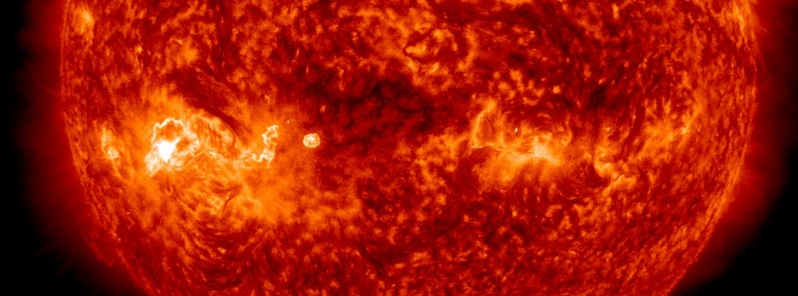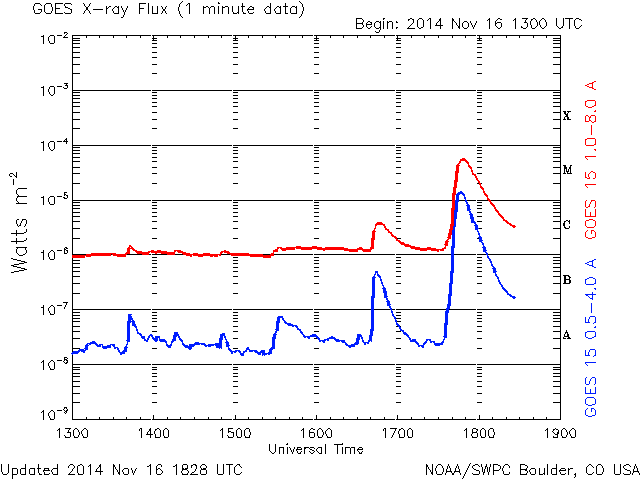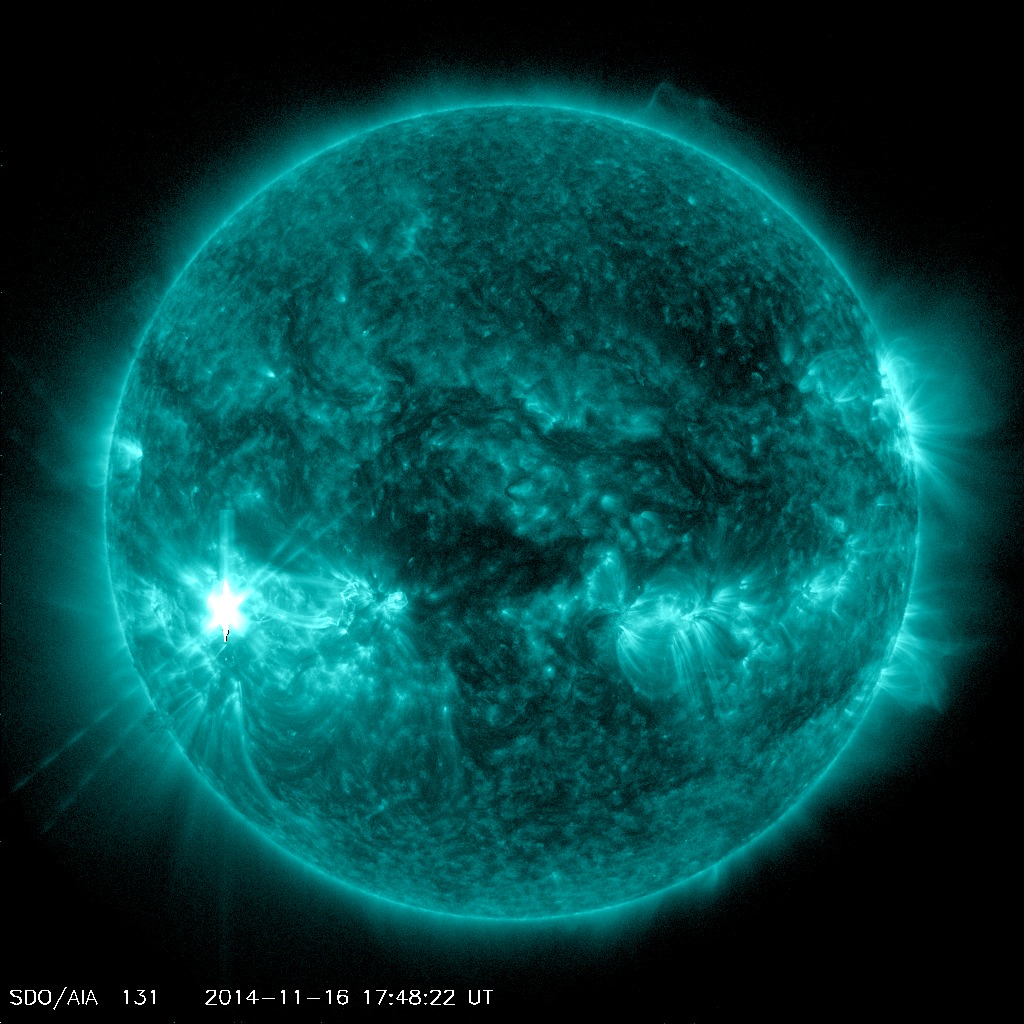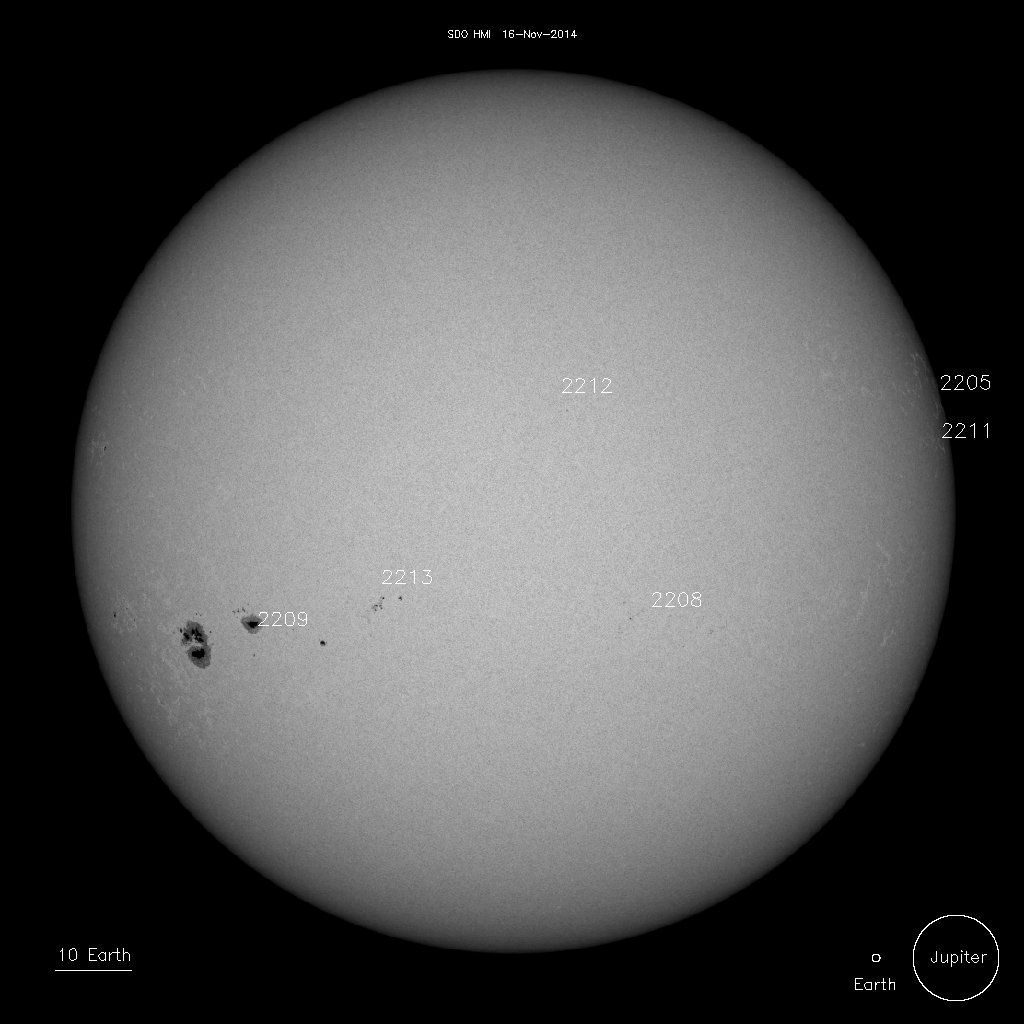Strong M5.7 solar flare erupted from Region 2209

A strong solar flare measuring M5.7 at its peak time erupted from Region 2209 on November 16, 2014. The event started at 17:35, peaked at 17:48 and ended at 17:57 UTC.
Region 2209 ('beta-gamma-delta') is Old Region 2192, source of six X-class solar flares during late October. Its location is still not favorable for Earth directed Coronal Mass Ejections (CMEs).
A 10cm Radio Burst lasting 1 minute (peak flux 300 sfu) was associated with the event. This can be indicative of significant radio noise in association with a solar flare. This noise is generally short-lived but can cause interference for sensitive receivers including radar, GPS, and satellite communications.
This region was the source of two M-class solar flares yesterday – M3.2 at 12:03 and M3.7 at 20:46 UTC. Both appeared to have associated CMEs, but analysis of both concluded that the majority of the ejecta was too far east of the ecliptic plane, presenting little threat of impact to Earth from either. This region was also responsible for a handful of low-level C-class flares as well as several sub-faint optical flares.
The next three days (November 16 – 18) are likely to see solar activity at moderate levels (R1-R2/Minor-Moderate) with a slight chance for an X-class flare (R3-Strong or greater). Continued significant flare activity from Region 2209 will be the most likely source of the increased solar activity.

Space Weather Message Code: SUM10R
Serial Number: 646
Issue Time: 2014 Nov 16 1802 UTC
SUMMARY: 10cm Radio Burst
Begin Time: 2014 Nov 16 1744 UTC
Maximum Time: 2014 Nov 16 1745 UTC
End Time: 2014 Nov 16 1745 UTC
Duration: 1 minutes
Peak Flux: 300 sfu
Latest Penticton Noon Flux: 161 sfu
Description: A 10cm radio burst indicates that the electromagnetic burst associated with a solar flare at the 10cm wavelength was double or greater than the initial 10cm radio background. This can be indicative of significant radio noise in association with a solar flare. This noise is generally short-lived but can cause interference for sensitive receivers including radar, GPS, and satellite communications.
Space Weather Message Code: SUMXM5
Serial Number: 129
Issue Time: 2014 Nov 16 1821 UTC
SUMMARY: X-ray Event exceeded M5
Begin Time: 2014 Nov 16 1735 UTC
Maximum Time: 2014 Nov 16 1748 UTC
End Time: 2014 Nov 16 1757 UTC
X-ray Class: M5.7
Location: S12E46
NOAA Scale: R2 - Moderate
Potential Impacts: Area of impact centered primarily on sub-solar point on the sunlit side of Earth.
Radio - Limited blackout of HF (high frequency) radio communication for tens of minutes.

Sunspots
There are currently 6 numbered sunspot regions on the visible solar disk.
Region 2209 exhibited minor growth in its intermediate spots during last 24 hours, while Regions 2205 (N15W85, Hax/alpha), 2208 (S11W16, Bxo/beta), 2211 (N08W77, plage), and 2212 (N16W05, Axx/alpha) all displayed some degree of decay.
Region 2213 (S09E17, Dai/beta) exhibited slight separation between the leader and trailer spots, and did have more intermediate spot development.

Sunspots on November 16, 2014. Image credit: NASA SDO / HMI
2205 – Beta
2208 – Beta
2209 – Beta-Gamma-Delta
2211 – Alpha
2212 – Alpha
2213 – Beta
Geomagnetic field
The geomagnetic field was at quiet to active levels with isolated minor to severe storming (G1-Minor to G3-Strong) at higher latitudes during last 24 hours. The increase in activity is likely associated with the arrival of the co-rotating interaction region (CIR) and beginning of the coronal hole high speed stream (CH HSS).
Following the arrival of the earlier CIR, the subsequent positive polarity CH HSS is expected to influence the geomagnetic field for the remainder of November 16 causing an increase in activity to active to minor storm (G1-Minor) levels. Quiet to active levels, with a slight chance for G1-Minor storm levels, are expected to continue during November 17 and 18 as CH HSS activity persists.
Featured image: NASA SDO / AIA 304

The geomagnetic field was at quiet to active levels with isolated minor to severe storming (G1-Minor to G3-Strong) at higher latitudes during last 24 hours. The increase in activity is likely associated with the arrival of the co-rotating interaction region (CIR) and beginning of the coronal hole high speed stream (CH HSS).
Following the arrival of the earlier CIR, the subsequent positive polarity CH HSS is expected to influence the geomagnetic field for the remainder of November 16 causing an increase in activity to active to minor storm (G1-Minor) levels. Quiet to active levels, with a slight chance for G1-Minor storm levels, are expected to continue during November 17 and 18 as CH HSS activity persists.